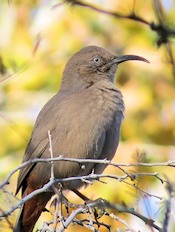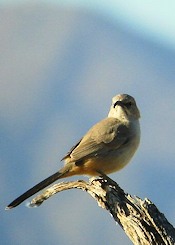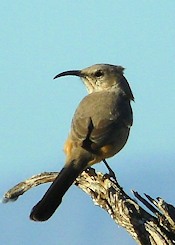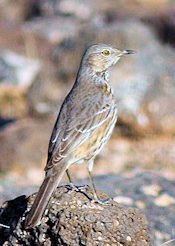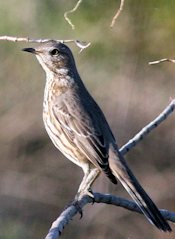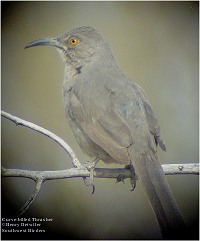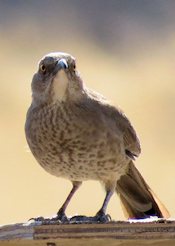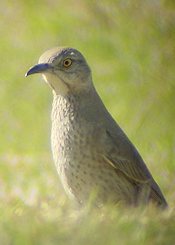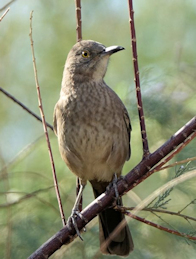Southwestern Thrashers
Latest update: 17 Feb 2024
Thrashers are some of the most elusive and sought-after birds in the United States. Here in the extreme southwest the following species all breed: Bendire's, Curve-billed, California, Crissal, LeConte's, and Sage. Their breeding ranges are summarized in the following table.
| Species | Range |
|---|---|
| Bendire's Thrasher | Arizona - throughout the state in every county California - Mohave Desert |
| Curve-billed Thrasher | Arizona - southern and central part of the state from 600-5200 feet - absent from low-lying areas of Yuma County |
| California Thrasher | California - western mountains and coastline |
| Crissal Thrasher | Arizona - all but the far northeastern corner of the state California - southeast part of the state east of the Laguna Mountains |
| Le Conte's Thrasher | Arizona - southwest, south-central, and western counties California - south of Borrego Springs and in the Imperial Dunes |
| Sage Thrasher | Arizona - northern third of the state, north of the Grand Canyon and in the Navajo Nation |
During March you may also find migrating Sage Thrashers in suitable habitat throughout Arizona and southern California; if there is enough food, these thrashers will also winter in central and southern Arizona.
In addition to our usual complement of thrasher species, an occasional vagrant Brown Thrasher appears almost annually somewhere in our area, giving an enterprising individual the opportunity to chase down seven species of thrashers in one day!
This introduction to our thrashers will give you some hints that may help you track down these birds, concentrating on identification, habitat, and reliable locations to look for them.
Habitat
Most of our thrashers prefer specific habitats, but as with other bird species, they may wander and be found wherever they can find suitable cover and food.
| Species | Preferred Habitat |
|---|---|
| Bendire's Thrasher | The most widespread Arizona thrasher, found in Sonoran desertscrub associations, brushy grasslands, parks, and rural areas |
| Curve-billed Thrasher | A wide range of desert habitat, foothills, and urban areas - fond of nestng in cholla and low thorny shrubs |
| California Thrasher | Chaparral and other dense brush in mountains and coastal areas |
| Crissal Thrasher | Thick shrubbery and dense mesquite stands, often along washes and drainages |
| Le Conte's Thrasher | Sparse, dry, flat deserts with scattered saltbrush, bursage, and other shrubs - does not usually frequent well-watered Sonoran desert with cholla and saguaros. |
| Sage Thrasher | Known for being a sagebrush species, but can be found in almost any type of open shrublands |
Best Spots to Look
There are many spots to look for these thrashers, but some locations are definitely easier than others! Here are some suggestions on where to spot these often elusive birds.
| Species | Where to Look |
|---|---|
| Bendire's Thrasher | Kofa National Wildlife Refuge (NWR), AZ: Check the washes crossing King Valley Road, about 2 miles east of Hwy 95.
One pair frequently nests close to where the dirt road cuts off to Horse Tanks. Apache Junction, east of Phoenix, AZ: Check Prospector Park in the northern portion of the city, where they can be found hopping around in the grass, especially in the early spring. |
| Curve-billed Thrasher | Phoenix, AZ: Check any of the parks, open spaces, or neighborhoods which have chollas growing in them. Tucson, AZ: Sonora National Monument or any of the cactus-filled yards on the north side of Tucson have plenty of these common thrashers. |
| California Thrasher | Jacumba, CA: There is a resident pair close to the pond on the west side of Jacumba. Easy to approach and photograph, too. San Elijo Lagoon, CA: Take the trail from the end of Rios Ave down into the canyon. The thrashers are often seen singing from atop a bush or a tree in the chaparral-lined hillside, especially in the spring. |
| Crissal Thrasher | Yuma West Wetlands, AZ: Very easy to spot on a walk on the west side of the Yuma West Wetlands, especially in early spring, and then again in the fall when the young are running about. Kofa NWR, AZ: Along with a number of other thrasher species, the Crissals like the thick brush in Kofa Queen Canyon. |
| Le Conte's Thrasher | West of Phoenix (Salome Highway and Baseline Road): Look in the mesquite and brushy desert west
of this intersection in the late winter (or early spring) for these thrashers. The area has recently been impacted by the construction of a solar farm,
so it is not like it used to be. This was the default location to search for these birds, due mainly to its proximity to Phoenix. Tacna, AZ: I've always had better luck finding Le Conte's in the area 5 miles east and 2 miles north of Tacna, in the huge fields of four-wing saltbush. February and March are the easiest months, when the birds will often perch and sing. As with other thrashers, a scope is often helpful. |
| Sage Thrasher | Kofa National Wildlife Refuge (NWR), AZ: Check the washes crossing King Valley Road in early to mid-March, when these birds are at the peak of their northward migration. Spot Road Farm, AZ is another excellent place to find these birds during migration. From the perimeter road check the surrounding desert brush. In northern Arizona, north of the Grand Canyon, check sagebrush and shrubby country in late March and April, when they are singing. |
Identification Hints
Some of these thrashers look quite similar to each other. Many have the same build and they are all colored with earth tones. The differences between a couple of the species are quite subtle. But a combination of voice, habitat, and these ID keys should make the identification challenges a bit simpler.
Click on the underlined bird links to take you to more detailed information on that particular species of bird.
| Species | Identification Hints |
|---|---|
| Bendire's Thrasher | Quite similar to Curve-billed Thrasher, but with a fairly straight lower mandible. But beware young Curve-billed Thrashers in the summer, which also have a fairly straight bill. Look for small triangular spots on the breast. To see more ID information and to listen to the song, click on the link to the left. |
| Curve-billed Thrasher | Similar to Bendire's Thrasher, but has less distinct, more roundish spots on the breast and a more curved bill. This is the most common thrasher in urban settings, and is the least shy of all the thrashers. The two part whistle call from this thrasher is diagnostic and frequently heard. To see more ID information and to listen to both the song and the call, click on the link to the left. |
| California Thrasher | The largest of the thrashers, it is 12" in length. Large-billed and long-tailed, with a dark eye-line, buffy breast without spots, and a dark iris. It is the only thrasher likely to be seen in the mountain and coastal chaparral of California. Calls can be found here: www.xeno-canto.org/species/Toxostoma-redivivum |
| Crissal Thrasher | Another large thrasher with buffy underparts and a large curved bill. Look for the rufous undertail coverts. Be on the look-out for similarly-shaped Abert's Towhees flying low and quick from bush to bush--make sure you see the long bill to confirm your ID! To see more ID information and to listen to the calls and songs, click on the link to the left. |
| Le Conte's Thrasher | This light tan thrasher has a long curved bill, tawny undertail coverts, and dark eyes. It's the palest of the thrashers, and also has a buffy un-spotted breast. Best looked for in the late winter, when it will sit up on a bush or a mesquite and sing. Often seen running along the ground with its tail cocked high in the air, from the cover of one bush to another. From a distance, may be confused with Sage Sparrows, who also scurry from bush to bush in the same manner. Calls and songs are at: www.xeno-canto.org/species/Toxostoma-lecontei |
| Sage Thrasher | This streaked thrasher with its white wing bars resembles a young mockingbird, especially from a distance. Luckily, there are no young mockingbirds around in March,
when this bird is migrating through our area. The white-cornered tail, streaked underparts, and yellow eye are diagnostic. Prefers sage-like habitat and brushy areas,
even during migration. Calls and songs are at: www.xeno-canto.org/species/Oreoscoptes-montanus |
